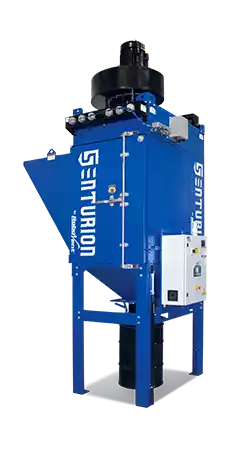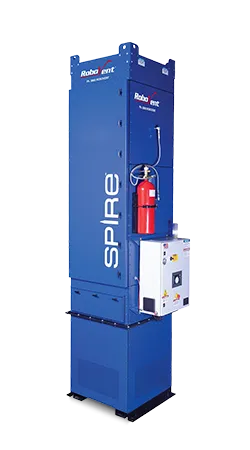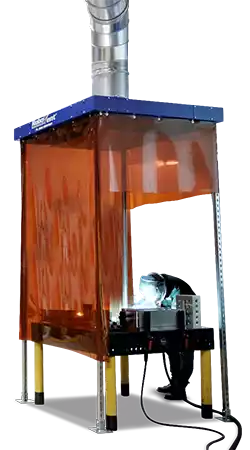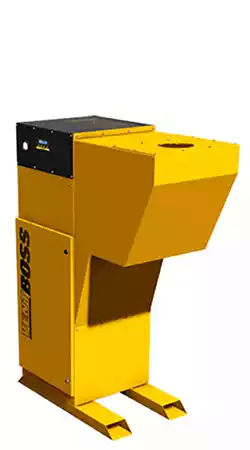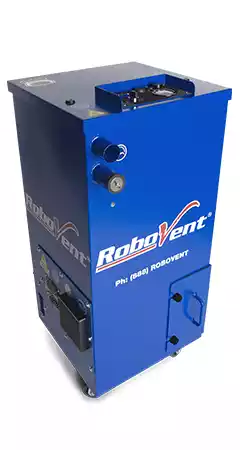WELD FUME EXTRACTORS
Find the Perfect Workspace for Manual and Robotic Welding
Effective weld fume extraction is a requirement for any manual or robotic welding operation. RoboVent has a full lineup of weld fume extraction solutions, including industrial dust collectors, portable hi-vac extractors, welding tables with built-in fume extraction, fume guns and more. We can help you find the perfect weld fume extractor for your operations, whether you have a handful of manual welding booths or a factory full of large robotic weld cells.
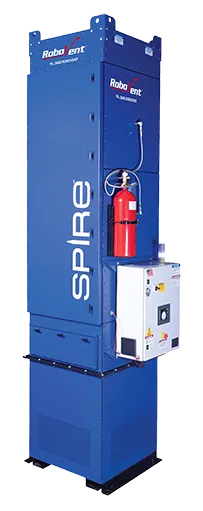
WELD FUME EXTRACTION SOLUTIONS
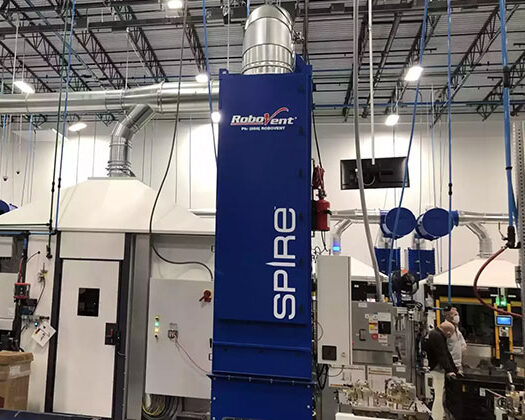 Robotic welding requires a heavy-duty weld fume extractor to keep fumes under control. Where possible, the robotic welding cell should be contained under a hood or enclosure to keep fumes from propagating through the facility. Robotic tip extractors can also be used to remove weld fume at the source.
Robotic welding requires a heavy-duty weld fume extractor to keep fumes under control. Where possible, the robotic welding cell should be contained under a hood or enclosure to keep fumes from propagating through the facility. Robotic tip extractors can also be used to remove weld fume at the source.
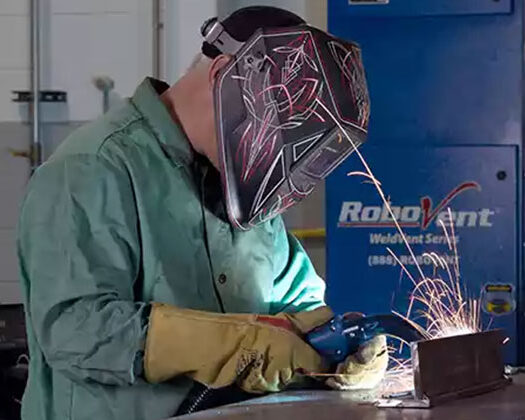 Manual welding fume extractors keep welders safe by removing weld fume from the breathing zone. Where possible, source-capture fume extractors should be used to minimize exposure and prevent fugitive fumes from moving through the facility. Source capture extractors for manual weld fume include fume arms, backdraft plenums, and fume guns (on-torch extractors).
Manual welding fume extractors keep welders safe by removing weld fume from the breathing zone. Where possible, source-capture fume extractors should be used to minimize exposure and prevent fugitive fumes from moving through the facility. Source capture extractors for manual weld fume include fume arms, backdraft plenums, and fume guns (on-torch extractors).
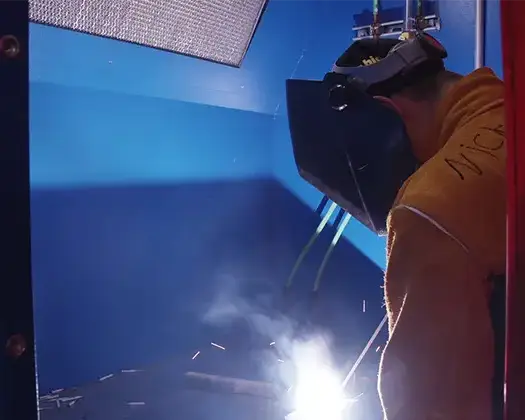 All-in-one welding booths or welding tables with fume extraction combine a convenient surface for manual welding with a built-in filtration system. A backdraft fume extractor pulls fumes up and away from the welder’s face and into the filter chamber. Perfect for stationary manual welding of tabletop components.
All-in-one welding booths or welding tables with fume extraction combine a convenient surface for manual welding with a built-in filtration system. A backdraft fume extractor pulls fumes up and away from the welder’s face and into the filter chamber. Perfect for stationary manual welding of tabletop components.
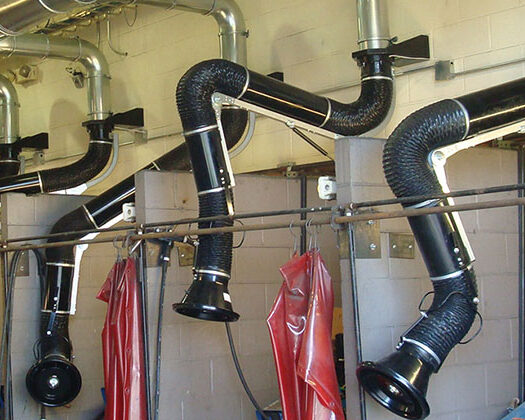 Looking for a versatile close-capture weld fume extractor? Fume arms are an industry standby for manual welding. These movable extraction arms are positioned directly over the weld seam to capture weld fume as it is created. Fume extraction arms can be ducted to a centralized dust collection system or mounted to a portable, floor-mounted or wall/ceiling-mounted filtration unit.
Looking for a versatile close-capture weld fume extractor? Fume arms are an industry standby for manual welding. These movable extraction arms are positioned directly over the weld seam to capture weld fume as it is created. Fume extraction arms can be ducted to a centralized dust collection system or mounted to a portable, floor-mounted or wall/ceiling-mounted filtration unit.
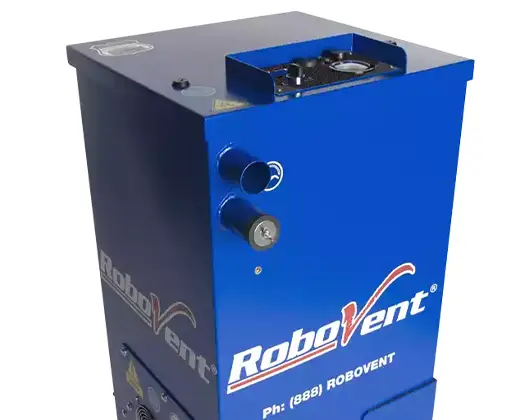 Portable weld fume extractors are a simple and flexible solution for collection of weld fumes from manual welding or light-duty robotic welding. Portable hi-vac extractors can be paired with a MIG fume gun for manual welding. Other portable units provide integrated filtration and fume extraction via a backdraft plenum or fume arm.
Portable weld fume extractors are a simple and flexible solution for collection of weld fumes from manual welding or light-duty robotic welding. Portable hi-vac extractors can be paired with a MIG fume gun for manual welding. Other portable units provide integrated filtration and fume extraction via a backdraft plenum or fume arm.
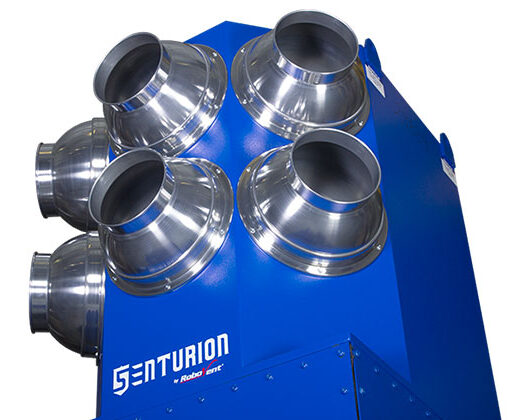 Ambient fume extractors pull contaminants right from the air to reduce exposure to dangerous dust and fumes. While source capture is the gold standard for weld fume extraction, ambient dust collection is sometimes used for general ventilation or as a secondary filtration solution.
Ambient fume extractors pull contaminants right from the air to reduce exposure to dangerous dust and fumes. While source capture is the gold standard for weld fume extraction, ambient dust collection is sometimes used for general ventilation or as a secondary filtration solution.
OUR BEST-SELLING WELD FUME EXTRACTORS

FREQUENTLY ASKED QUESTIONS ABOUT WELDING FUME EXTRACTORS
Weld Fume Extractors
What are weld fume extractors?
Weld fume extractors are specialized ventilation systems designed to capture and filter harmful fumes and particulates generated during welding processes. They help create a safer and cleaner working environment by removing potentially toxic substances from the air, thereby reducing the risk of respiratory issues and other health problems for welders and nearby personnel.
These systems can vary in size and design, ranging from portable units to large, centralized fume extraction systems. They can also be equipped with various types of filters, such as HEPA and activated carbon, to handle different kinds of pollutants. Weld fume extractors can be used in both manual and robotic welding applications and are essential tools for maintaining air quality and compliance with occupational safety standards.
Why are weld fume extractors needed?
Weld fume extractors are needed to keep welders safe and keep facilities compliant with OSHA permissible exposure limits (PELs) for weld fume. By integrating weld fume extractors into your operations, you not only protect your workforce but also make a smart business decision that pays off in the long run. Weld fume extractors are crucial for multiple reasons:
- Health and Safety: Welding processes produce fumes that can contain harmful substances like toxic metals and gases. Prolonged exposure to these fumes can lead to serious health conditions such as lung disease, respiratory issues, and even neurological problems.
- Regulatory Compliance: Many countries have regulations that require employers to protect workers from hazardous fumes. Weld fume extractors help your workspace meet these legal requirements.
- Increased Productivity: A safe and comfortable work environment boosts productivity. Workers are more efficient when they are not worrying about inhaling harmful fumes.
- Equipment Longevity: Accumulated fumes and dust can corrode or damage equipment over time. Fume extractors help maintain the condition of your tools and workspace.
- Better Work Quality: Removing fumes and particles from the air via a weld fume extractor provides a clearer view of the workpiece, allowing for more accurate and higher-quality welding.
What types of fume extractors can be used for robotic welding?
Robotic welding requires heavy-duty weld fume extraction to keep up with high production.
- Robotic processes are often enclosed under a hood to prevent fume propagation. The hood may be ducted to an individual dust collector, such as RoboVent Spire™. Alternatively, multiple robotic cells may be ducted to a large centralized dust collector, such as RoboVent Senturion™.
- For applications that cannot be easily enclosed, on-torch tip extraction, such as RoboVent FlexTrac™, provides a simple and effective solution. These systems collect weld fume right at the source as it is produced. The tip extractor is connected to a high-vacuum dust collection unit like RoboVent FlexPro™.
What types of fume extractors can be used for manual welding?
Manual welding requires a fume extraction system that will keep weld fumes away from the welder’s face. This usually requires a source capture system. Weld fume extractors commonly used for manual welding include:
- Fume arms, which are positioned over the weld seam to collect fumes.
- Backdraft plenums, which are positioned behind the welding surface to pull weld fumes up and away from the breathing zone.
- Fume guns, or extraction torches, which integrate fume extraction into the torch itself.


